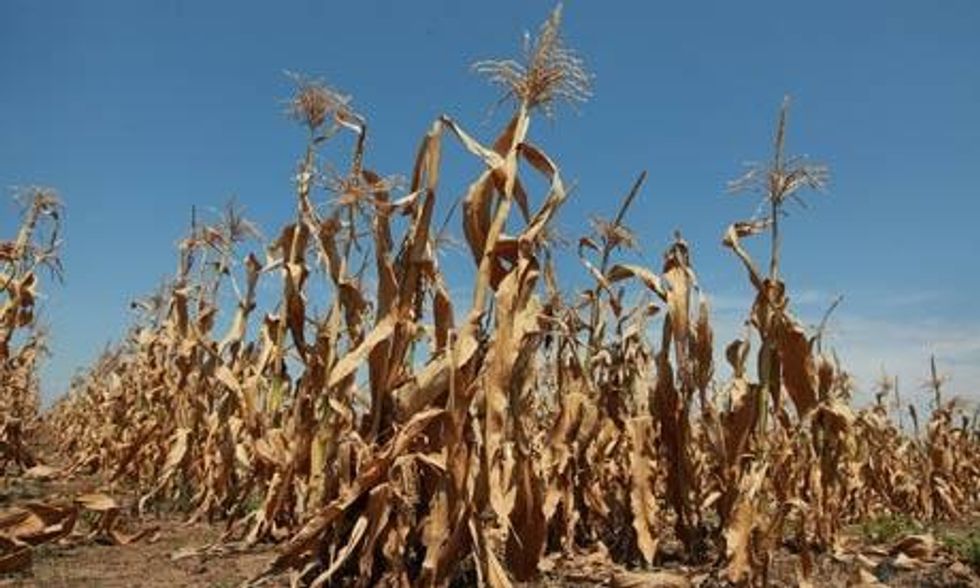If you're wondering whether the US drought will create a global food crisis, the answer's easy. It's yes, because there's a food crisis already. The latest year for which we have figures is 2010, when 925 million people were declared malnourished. Soon after the number was announced, the World Bank corrected it upward, and recently said that the number of hungry people is "almost 1 billion".
Make no mistake: the US drought is fierce. In June this year, out of a possible 171,442 temperature records, 2,284 were broken and 998 were tied. The London Olympic Games should be so lucky. The drought isn't merely bad because the crops are parched. Climate change has nudged the temperature more than a degree higher than the previous record-breaking US drought in the 1950s. The heat is killing natural systems, and making recovery far harder. We don't yet know what the final reckoning will be for food prices. Corn hit a record $8 a bushel on Monday (in September 2006, the price was nearer $2 a bushel). The price is driven by a demand for animal feed, high-fructose corn syrup, and an incredibly stupid US biofuels policy that mandates the transformation of food into ethanol. With the US producing over half of world corn exports, and with the price of those exports set by domestic uses of corn, the US drought will have a profound impact on prices.
Other grains aren't having a great year either. The US is a major soy exporter, and prices have soared over the past few days. Nor is America the only place to suffer extreme weather. This year, a late monsoon in India, and an ongoing southern European heatwave, add to the uncertainty about harvests and crops.
Uncertainty is profitable. The Food and Agriculture Organization is worried about price swings, even though prices are far from their 2011 peaks. Volatile prices create markets for hedge funds to trade and gamble on future trends. Traders, enabled by lax futures regulations, are perhaps the only people to see the bright side of the beating sun.
Which is why it's worth looking to history. Record-breaking weather, farmers losing crops, banks repossessing land from the poor, a president scorned by his opponents for socialism. We've seen this before. Such were the conditions of the dust bowl in the 1930s. Then, the drought stretched across most of the decade. By 1938, 80% of the Great Plains had been damaged by wind erosion. In large part, it was because farmers on small farms weren't taking care of the soil. What would bring farmers to the point of destroying the soil on which they depended? Most of them were deeply indebted to banks, and hanging on by their fingernails. Environmental destruction staved off financial oblivion.
In response, the Soil Conservation Service was created to help farmers directly. But farmers' financial crises needed more than tree-planting. The dust bowl was also tackled with changes in the banking system, regulation to stop foreclosure, stabilization policies to stop wild swings in prices, and even, as part of the New Deal, employment in the Worlds Progress Administration to help the former family farmers cast off their land for ever.
These policies didn't come easily. They were the fruits of widespread organizing, from the work of socialist leagues to the populism of Huey Long. All of this is worth recording, because in the wake of the 2008 food price crisis, so little has changed. The US government hasn't sufficient grain in its reserves to stabilize prices. Public grain reserves were shrugged off in the 1990s as inefficient. No sense in having mountains of grain when, in a pinch, the market could be counted on to provide. Perish the thought that governments might intervene in the banking sector, or engage in public works programs so that the hungry, 60% of whom are women or girls, might afford to eat.
Instead, the US secretary of agriculture, Tom Vilsack, has this to offer: "I get on my knees every day, and I'm saying an extra prayer now. If I had a rain prayer or a rain dance I could do, I would do it." So politicians, parched of ideas, are supine. They chant mantras about the sparkle of the agricultural and financial innovation that will, soon, provide relief. But the heat is strong and the sun is high. Their oasis is a mirage.

